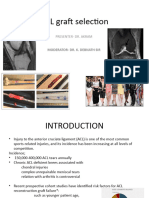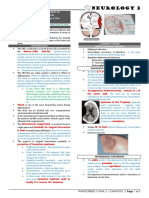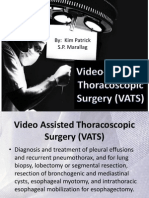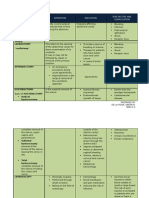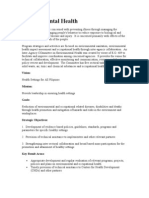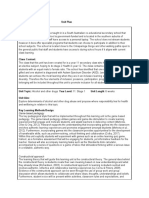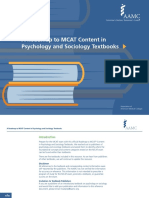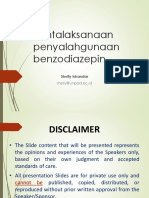RSOP Pneumatic Tourniquets
RSOP Pneumatic Tourniquets
Uploaded by
dr_hafizCopyright:
Available Formats
RSOP Pneumatic Tourniquets
RSOP Pneumatic Tourniquets
Uploaded by
dr_hafizCopyright
Available Formats
Share this document
Did you find this document useful?
Is this content inappropriate?
Copyright:
Available Formats
RSOP Pneumatic Tourniquets
RSOP Pneumatic Tourniquets
Uploaded by
dr_hafizCopyright:
Available Formats
Recommended Standards of Practice for Safe Use of Pneumatic Tourniquets
Introduction The following Recommended Standards of Practice were researched and written by the AST Education and Professional Standards Committee and have been approved by the AST Board of Directors. They are effective April 13, 2007. AST developed the following Recommended Standards of Practice to support health care facilities in the reinforcement of best practices related to the safe use of pneumatic tourniquets in the perioperative setting. The purpose of the Recommended Standards is to provide an outline that surgical team members can use to develop and implement policies and procedures for the safe use of pneumatic tourniquets. The Recommended Standards is presented with the understanding that it is the responsibility of the health care facility to develop, approve, and establish policies and procedures for the safe use of pneumatic tourniquets according to established health care facility protocols. Rationale The following are Recommended Standards of Practice related to the safe use of pneumatic tourniquets in the perioperative setting. The pneumatic tourniquet is utilized during extremity surgery to maintain a bloodless field and/or prevent an IV regional anesthetic drug from exiting an extremity, eg Bier block. A tourniquet applies pressure to the limb to occlude the blood supply to the operative limb. Even though the pneumatic tourniquet has been placed in the lowest risk category for medical devices by the Food and Drug Administration, the pneumatic tourniquet can cause nerve, vessel and tissue injuries to the patient, temporary or permanent, due to incorrect cuff placement, excessive tourniquet pressure, prolonged inflation and improper protection of the skin underlying the tourniquet.9,10 The most commonly reported complication is nerve paralysis followed by deep-vein thrombosis.1 The safety of the patient is of utmost importance when using the pneumatic tourniquet. The components of the pneumatic tourniquet consist of the: Inflatable cuff: Consists of a rubber bladder that is within a plastic or fabric covering. Cuffs may be a single cuff that contains a single chamber for the air or a double cuff that contains two chambers. Connective tubing: Connects the cuff to the pressure device Pressure device: Consists of the air compressor, buttons for setting the pressure, digital display of the pressure setting, and timer. The pressure device is run by electricity, therefore the unit is plugged into a wall outlet. Some units contain a battery that can run the device for a short period of time during power outages. Different styles, types and sizes of pneumatic tourniquets are available. As mentioned above, there are tourniquets available with one or two cuffs; different sizes of cuffs that
can be chosen according to the size and age of the patient, eg pediatric cuffs; and contour tourniquets that are shaped more to the natural contour of the extremities. Additionally sterile disposable pneumatic tourniquets are available for use for those surgical cases when the operative site is close in proximity to the edge of the tourniquet.
Standard of Practice I
Surgical team members should complete training to demonstrate the knowledge and competency in the proper use of the pneumatic tourniquet. 1. Surgical team members should complete training in tourniquet application that includes return demonstrations in a lab/mock setting and application of the tourniquet under close physician supervision for a predetermined number of patients. 2. The training should include didactic studies that discuss the complications that may arise from improper tourniquet application, understanding the factors that can affect the patient preexisting pathophysiological condition(s), correct pressure settings and operating the pressure device. 3. At the minimum, surgical team members should complete annual competency assessment and continuing education to remain current in their knowledge of the pneumatic tourniquet, including new technological advances and their effect on patient care and safety, and health care facility costs.
Standard of Practice II
Health care facilities should review the policies and procedures for the use of pneumatic tourniquets and method of determining competency according to a specified schedule. 1. The policies and procedures should at the minimum address the following: A. Surgical team members recognized as having received the proper training and can be responsible for the application of the cuff. B. Surgical team members who have received the proper training on monitoring the pressure device while in use. C. Surgical team members who can complete the documentation related to the use of the pneumatic tourniquet. D. Establish documentation of maintenance, testing, inspection and cleaning of the pressure device and cuffs at regular intervals by the biomedical technicians. E. Establish methods for the care and handling of non-disposable cuffs. F. Review and provision of continuing education of surgical team members.. 2. Procedures should be established addressing documentation and record keeping at regular intervals of the biomedical inspection and preventive maintenance of the tourniquet system(s) that are in the surgical suite.7 Documentation of each tourniquet system should include the assigned biomedical/health care facility identification number, manufacturers serial number, date(s) of inspection and preventive maintenance, and comments related to the effectiveness level of the equipment .7
3. If a pneumatic tourniquet malfunctions and is determined to be the cause of a patient injury or contributing factor to a patient death, the health care facility is required to report the incident and related information to the manufacturer of the tourniquet system and to the US Food and Drug Administration which is required according to the Safe Medical Devices Act of 1990.13
Standard of Practice III
Pneumatic tourniquets should be inspected and tested prior to patient use. 1. Prior to the patient entering the O.R, the pneumatic tourniquet system should be tested and thoroughly inspected. The cuff and tubing should be checked to confirm they are clean, and no cracks and/or leaks are present.11 All connections, including stopcocks, should be inspected. 2. The pneumatic tourniquet should be slightly pre-inflated and deflated to test the system.11 3. Manufacturers written instructions should always be followed.
Standard of Practice IV
Non-disposable cuffs and tubing should be cleaned and decontaminated between patient uses according to manufacturers instructions. 1. The cuff and tubing should be thoroughly rinsed of cleaning agents to avoid irritation of the patients skin. Introduction of the cleaning agent and rinsing solution into the ports should be avoided since the solutions can damage the tourniquet system. 2. The tubing and pressure device should be wiped down with an intermediate- or high-level tuberculocidal disinfectant solution. The tubing should be dried of the solution to prevent the protective outer rubber from drying and cracking. 3. If blood and/or body fluids are observed on the cuff and/or tubing, an intermediate- or high-level tuberculocidal disinfectant solution should be used, as well as an enzymatic solution in order to prevent patient and surgical team member exposure to bloodborne pathogens.
Standard of Practice V
Surgical team members should be knowledgeable of the contraindications for pneumatic tourniquet use. 1. The following are contraindications for the use of the pneumatic tourniquet: A. Open fractures (1) In the instance of closed fractures, exsanguinations may not be able to be accomplished with the use of an elastic wrap, eg Esmarch bandage. Use of the bandage could further injure the patient. Elevation of the extremity may be the only route of accomplishing some degree of exsanguination. However, elevation also may not be able to be accomplished due to the possibility of causing further neurovascular damage. B. Post-traumatic lengthy hand reconstruction C. Severe crushing injuries
D. E. F. G. H. I. J.
Severe hypertension Skin grafts Peripheral artery disease Diabetes mellitus Sickle cell anemia Compartment syndrome Malignant tumors
Standard of Practice VI
Surgical team members should follow the Recommended Standards for applying the tourniquet cuff, tourniquet use and establishing the pressure settings for the adult patient to avoid patient injury. 1. Tourniquet systems use nitrogen or air to inflate the cuff bladder. The manufacturers written instructions should be followed in order to select the correct gas to be used with the tourniquet system. Oxygen should not be used to inflate the cuff bladder since this increases the risk of fire in the O.R.5 2. To reduce intraoperative and postoperative complications, the appropriate size of tourniquet should be chosen according to the characteristics of the patient, eg size of limb, shape of limb, preexisting conditions, type of surgical procedure. The following is recommended: A. The widest cuff possible should be chosen. Wide bladders can occlude the blood flow with the use of a lower cuff pressure, thus reducing the risk of injury to the patient.8 B. A minimum of two layers of padding should be placed around the extremity as proximal to the surgical skin incision as possible. Cotton-cast padding, sheet padding or Webril should not be used due to their shedding of loose fibers/lint that can become embedded in the contact closures with the skin and reduce their effectiveness. 8 Additionally, studies have shown the best results for the protection of the skin is with the use of an elastic stockinette; the stockinette produces significantly fewer pinches and wrinkles of the skin, as compared to other types of padding, including cast padding.12 C. The tourniquet size should be half of the limb diameter. D. The cuff should overlap between three to six inches. If the overlap is more than six inches, rolling and wrinkling of the underlying skin and increased pressure in the area of the overlap may occur. E. The choice of size of tourniquet should allow placement of two fingers between the cast padding and the cuff. F. The choice of using a contour cuff may be optimal in particular patient situations.10 Contour cuffs occlude the flow of blood at lower pressures than straight cuffs that are of the same width.16 Contour cuffs are recommended when the extremity is particularly muscular and for use on obese patients to avoid the risk of shearing. 3. The tourniquet cuff should be applied according to manufacturers written instructions, health care facility policies and procedures, and standards that have been established through research. These include:
A. Patient general health assessment should be confirmed prior to tourniquet placement and use. B. The integrity and quality of the patients skin should be assessed prior to tourniquet placement and use, and documented in the patients O.R. record. C. When applying the cuff to an obese patient, it is recommended that the surgical assistant apply distal traction to the skin and tissue of the extremity with the use of the hands to smooth out the skin, while the cast padding and tourniquet cuff are applied. D. After the cuff is applied and the patient skin prep is being performed, the prep solution should not be allowed to pool around, or under the cuff, to prevent chemical burn to the patients skin.2 E. The cuff should be covered to reduce gross contamination from the surgery site. Typically the edge of a U-drape is positioned around the distal edge of the tourniquet cuff and unfolded toward the head of the patient to cover the cuff. F. When possible, the extremity should be exsanguinated prior to the inflation of the cuff. An Esmarch bandage is most commonly used. Adequate exsanguination aids in creating the bloodless field. G. The ideal tourniquet pressure has not yet been determined. The minimum pressure should be used. The surgeon considers many clinical factors when determining the cuff pressure, including size and weight of patient, patient preexisting conditions, extremity circumference, blood pressure, etc. The guidelines for tourniquet pressure for the adult are: (1) 50 mm Hg above the patients systolic blood pressure for upper extremities.2 (2) 100 mm Hg above the patients systolic blood pressure for lower extremities.2 H. The inflation time of the cuff should be minimized as much as possible. The following are recommendations related to tourniquet inflation time: (1) The surgeon should be informed when the cuff has been inflated for the first 60 minutes. (2) Sixty minutes is the recommended inflation time for upper extremities and 90 minutes for lower extremities. (3) When the recommended time limit has been reached, it is recommended that the cuff be deflated for 15 minutes to allow for re-perfusion of the extremity, and then the cuff can be reinflated for another recommended time period, eg 60 or 90 minutes. (4) The limb should be re-exsanguinated prior to reinflation to avoid venous thromboses. I. The cuff should be deflated at the end of the surgical procedure as soon as feasible. (1) The cuff should be deflated according to the manufacturers written instructions.
(2) The cuff and cast padding should be immediately removed from the extremity upon deflation of the cuff.10 The cast padding should not be left on the patient as he/she is transported to the PACU or other department. The padding could contribute to poor venous return, causing venous pooling and thrombosis.
Standard of Practice VII
Surgical team members should follow the Recommended Standards for applying the tourniquet cuff, tourniquet use and establishing the pressure settings for the pediatric patient to avoid patient injury. 1. To reduce intraoperative and postoperative complications, the appropriate size of tourniquet should be chosen according to the characteristics of the patient, eg size of limb, shape of limb, preexisting conditions, type of surgical procedure. The following is recommended: A. The widest cuff possible should be chosen. Wide bladders can occlude the blood flow with the use of a lower cuff pressure, thus reducing the risk of injury to the patient. B. A minimum of two layers of padding should be placed around the extremity as proximal to the surgical skin incision as possible. Studies have shown cast padding to be preferred by the majority of surgeons.6 C. The tourniquet size should be half of the limb diameter.2 D. The cuff should overlap between three to six inches. If the overlap is more than six inches, rolling and wrinkling of the underlying skin and increased pressure in the area of the overlap may occur. E. The choice of size of tourniquet should allow placement of two fingers between the cast padding and the cuff. F. The choice of using a contour cuff may be optimal in particular patient situations. Contour cuffs occlude the flow of blood at lower pressures than straight cuffs that are of the same width. 2. The tourniquet cuff should be applied according to manufacturers written instructions, health care facility policies and procedures, and standards that have been established through research. These include: A. Patient general health assessment should be confirmed prior to tourniquet placement and use. B. The integrity and quality of the patients skin should be assessed prior to tourniquet placement and use, and documented in the patients O.R. record. C. It is recommended that the most proximal portion of the limb in pediatric patients be selected as the cuff location.15 D. After the cuff is applied and the patient skin prep is being performed, the prep solution should not be allowed to pool around, or under the cuff, to prevent chemical burn to the patients skin. E. The cuff should be covered to reduce gross contamination from the surgery site. For pediatric patients, a small drape with an adhesive bar across the top is recommended for use.
F. When possible, the extremity should be exsanguinated prior to the inflation of the cuff. An Esmarch bandage is most commonly used. However, studies are showing that the use of the Esmarch bandage may be too aggressive and has been linked to reports of pulmonary embolism.6 Adequate exsanguination aids in creating the bloodless field. G. The ideal tourniquet pressure has not yet been determined. Studies have established that the minimum pressure required to safely maintain a bloodless field (called the limb occlusion pressure (LOP) should be used and the lower pressure reduces the risk of complications.6 The surgeon considers many clinical factors when determining the LOP, including size and weight of patient, patient preexisting conditions, extremity circumference, blood pressure, cuff fit, and cuff design.6 The guidelines for tourniquet pressure for the pediatric patient are: (1) 50 mm Hg above the patients systolic blood pressure (2) Increase the pressure by 25 mm Hg increments if arterial bleeding is present until blood flow is stopped, but it is recommended to not exceed 100 mm Hg of the patients systolic blood pressure. H. The inflation time of the cuff should be minimized as much as possible. The following are recommendations related to tourniquet inflation time: (1) The surgeon should be informed when the cuff has been inflated for the first 60 minutes. (2) Sixty minutes is the recommended inflation time for upper extremities and lower extremities of the pediatric patient. (3) When the recommended time limit has been reached, it is recommended that the cuff be deflated for 15 minutes to allow for re-perfusion of the extremity, and then the cuff can be re-inflated for another recommended time period of 60 minutes. (4) The limb should be re-exsanguinated prior to re-inflation to avoid venous thromboses. I. The cuff should be deflated at the end of the surgical procedure as soon as feasible. (1) The cuff should be deflated according to the manufacturers written instructions. (2) The cuff and cast padding should be immediately removed from the extremity upon deflation of the cuff. The cast padding should not be left on the patient as he/she is transported to the PACU or other department. The padding could contribute to poor venous return causing venous pooling and thrombosis.
Standard of Practice VIII
Documentation of the use of the tourniquet should be included in the patients O.R. record. 1. Documentation should include the following: A. Preoperative and postoperative assessment of the integrity of the skin. B. Preoperative and postoperative assessment of the extremity.
C. Health care facility identification number and manufacturers serial number and model number D. Type of skin protection that was applied, eg cast padding, sleeve, stockinette E. Location of the cuff F. Cuff pressure G. Times cuff was inflated and deflated, including intraoperative deflation and inflation times. H. Name of person who applied the cuff. Competency Statements Competency Statements 1. Certified Surgical Technologists (CSTs) and Certified First Assistants (CFAs) are knowledgeable of the risks, patient hazards, and safety factors associated with the use of the pneumatic tourniquet. 2. The CST is qualified to assist the CFA and/or surgeon in the application of the tourniquet. 3. The CFA is qualified to apply the cast padding and tourniquet cuff to the patients extremity under the supervision of the surgeon. 4. The CFA is qualified to communicate the surgeons desired tourniquet pressure to the surgical team and operate the pressure device by establishing the pressure setting. Measurable Criteria 1. Educational standards as established by the Core Curriculum for Surgical Technology and Core Curriculum for Surgical Assisting.3,4 2. The subject of pneumatic tourniquets is included in the didactic studies as a surgical technology and surgical assistant student including concepts of patient care and safety that are appropriate to the role of the surgical technologist and surgical assistant. Additionally, the studies include the proper documentation in the patients O.R. record. 3. Surgical assistant students demonstrate knowledge of application of the tourniquet cuff in the lab/mock O.R. setting and during clinical rotation under supervision of the surgeon. 4. Surgical technology students demonstrate knowledge of assisting with the application of the tourniquet cuff during clinical rotation under supervision of the preceptor, instructors and surgeon. 5. As practitioners, CSTs and CFAs perform application of the tourniquet cuff, according to their specific role. Health care facilities whose protocols and policies allow, CSTs and CFAs record the required information in the patients O.R. record as
pertaining to the use of the pneumatic tourniquet. 6. CSTs and CFAs complete continuing education to remain current in their knowledge and skills of the safe use of pneumatic tourniquets, including review on a periodic basis of the policies and procedures of the health care facility.
References 1. Abdel-Salam A, Eyres KS. Effects of tourniquet during total knee arthroplasty. J Bone Joint Surg Am.1995; 77-B (2): 250-253. 2. Anaesthesia UK. Procedures under tourniquet. 2003. http://www.frca.co.uk/printfriendly.aspx?articleid=100406. Accessed October 18, 2006. 3. Core Curriculum for Surgical Assisting. 2nd ed. Littleton, CO: Association of Surgical Technologists; 2006. 4. Core Curriculum for Surgical Technology. 5th ed Littleton, CO: Association of Surgical Technologists; 2002. 5. ECRI. (1992). The patient is on fire: A surgical fires primer. Health Devices. 21, 19. 6. Kalla TP, Younger A, McEwen JA, Inkpen K. Survey of tourniquet use in podiatric surgery. J Foot Ankle Surg. 2003; 42(2): 68-76. 7. McEwen JA. Complications of and improvements in pneumatic tourniquets used in surgery. Medical Instrum. 1981; 15(4):253-257. 8. McEwen JA, Inkpen K. Tourniquet safety preventing skin injuries. Surgical Technol. 2002. 34(7): 6-15. 9. McEwen JA, Inkpen K. Surgical tourniquet technology adapted for military and prehospital use. 2004. http://handle.dtic.mil/100.2/ADA444880. Accessed March 25, 2007. 10. McEwen JA, Kelly DL, Jardanowski T, Inkpen K. Tourniquet safety in lower leg applications. Orthop Nurs. 2002; 21(5): 55-62.
11. Medical Device Safety Reports. Suggested guidelines for pneumatic tourniquet use. http://www.mdsr.ecri.org/summary/detail.aspx?doc_id=8251. Accessed October 19, 2006. 12. Olivecrona C, Tidermark J, Hamber P, Ponzer S, Cederfjall C. Skin protection underneath the pneumatic tourniquet during total knee arthroplasty. Acta Orthop. 2006; 77(3): 519-523. 13. THOMAS, Library of Congress. Safe medical devices act of 1990. http://thomas.loc.gov/cgibin/bdquery/z?d101:HR03095:@@@D&summ2=1&%7CTOM:/bss/d101query. 14. html%7C. Accessed March 25, 2007.
15. Tredwell SJ, Wilmink M, Inkpen K, McEwen JA. Pediatric tourniquets: Analysis of cuff and limb interface, current practice, and guidelines for use. J Pediatr Orthop. 2001; 21: 671-676. 16. Younger ASE, McEwen JA, Inkpen K. Wide contoured thigh cuffs and automated limb occlusion measurement allow lower tourniquet pressures. Clin Orthop Relat Res, 2004; 428: 286-293.
You might also like
- Acl Graft Selection PPTfinal LatestDocument29 pagesAcl Graft Selection PPTfinal LatestAkram JamiNo ratings yet
- Health Behavior TheoryDocument50 pagesHealth Behavior Theoryfani kurniaNo ratings yet
- NHA Phlebotomy Exam 2022-2023: Study Guide with 400 Practice Questions and Answers for National Healthcareer Association Certified Phlebotomy Technician ExaminationFrom EverandNHA Phlebotomy Exam 2022-2023: Study Guide with 400 Practice Questions and Answers for National Healthcareer Association Certified Phlebotomy Technician ExaminationNo ratings yet
- Thoracic TraumaDocument24 pagesThoracic TraumaOmar MohammedNo ratings yet
- Mass Casualty and Triage - MilitaryDocument18 pagesMass Casualty and Triage - MilitaryNestleNo ratings yet
- Amputation-Dr N K BeheraDocument8 pagesAmputation-Dr N K BeheraSheel GuptaNo ratings yet
- Acute Compartment SyndromeDocument15 pagesAcute Compartment SyndromeDea Sella SabrinaNo ratings yet
- Minor Surgical Procedures in Remote AreasDocument127 pagesMinor Surgical Procedures in Remote Areassharmeen khanNo ratings yet
- Hersheychapter 1Document17 pagesHersheychapter 1poddata100% (1)
- Definition/Description: Types of SyringomyeliaDocument8 pagesDefinition/Description: Types of SyringomyeliaNurfadiyah YasinNo ratings yet
- 0301omar Yusef Kudsi - Robotic Hernia Surgery - A Comprehensive Illustrated Guide-Springer International Publishing - Springer (2020)Document25 pages0301omar Yusef Kudsi - Robotic Hernia Surgery - A Comprehensive Illustrated Guide-Springer International Publishing - Springer (2020)ravikanth100% (1)
- Chapter 37: Laser Applications in Podiatric SurgeryDocument34 pagesChapter 37: Laser Applications in Podiatric SurgerypoddataNo ratings yet
- Chapter 3 and 3a Introduction To Orthopedics and Bio MechanicsDocument58 pagesChapter 3 and 3a Introduction To Orthopedics and Bio Mechanicspodmmgf100% (1)
- Posterior Cervical Triangle Anterior TrianglesDocument10 pagesPosterior Cervical Triangle Anterior TrianglesSaad AbdullahNo ratings yet
- Abdominal TraumaDocument60 pagesAbdominal Traumahsns88049No ratings yet
- Pelvis: Stable Pelvic FracturesDocument4 pagesPelvis: Stable Pelvic FracturesEloise PateñoNo ratings yet
- Chapter 23: RadiologyDocument23 pagesChapter 23: RadiologypoddataNo ratings yet
- Laparoscopic SurgeryDocument16 pagesLaparoscopic SurgeryHuda A LatifNo ratings yet
- Nutrition For Patients With Heart Failure.5Document5 pagesNutrition For Patients With Heart Failure.5Eileen del RosarioNo ratings yet
- Surgery PDFDocument112 pagesSurgery PDFKhaled AbdoNo ratings yet
- Chapter 1 - Central Venous CathetersDocument6 pagesChapter 1 - Central Venous CathetersParth PatelNo ratings yet
- Disasters and Mass Casualty Incidents: The Nuts and Bolts of Preparedness and Response to Protracted and Sudden Onset EmergenciesFrom EverandDisasters and Mass Casualty Incidents: The Nuts and Bolts of Preparedness and Response to Protracted and Sudden Onset EmergenciesMauricio LynnNo ratings yet
- History of LaparosDocument27 pagesHistory of LaparosDr. Sanjay KolteNo ratings yet
- The Vascular Phase: HaemostasisDocument12 pagesThe Vascular Phase: HaemostasisagestaraswitaNo ratings yet
- Definition, Classification, Etiology, and Pathophysiology of Shock in Adults - UpToDateDocument20 pagesDefinition, Classification, Etiology, and Pathophysiology of Shock in Adults - UpToDateEstructuración Técnica 2019No ratings yet
- Brachial Plexus by DR Chaman Lal PT CKDocument39 pagesBrachial Plexus by DR Chaman Lal PT CKChaman Lal KarotiaNo ratings yet
- Osteonecrosis: Avascular NecrosisDocument8 pagesOsteonecrosis: Avascular NecrosisJezreel BonaNo ratings yet
- Physical Examination of The Wrist and Hand. DanielDocument34 pagesPhysical Examination of The Wrist and Hand. DanielCut DianafitriaNo ratings yet
- Nerve InjuryDocument19 pagesNerve Injurybhavesh jain100% (2)
- Chapter 27: Muscle and Tendon PathologyDocument32 pagesChapter 27: Muscle and Tendon PathologypoddataNo ratings yet
- Slipped Capital Femoral EpiphysisDocument21 pagesSlipped Capital Femoral EpiphysisJulián RincónNo ratings yet
- Rheumatoid ArthritisDocument54 pagesRheumatoid ArthritisGökhan SüzenNo ratings yet
- Principles of Abdominal Wall Closure - UpToDateDocument32 pagesPrinciples of Abdominal Wall Closure - UpToDatesteve inga pomaNo ratings yet
- Post-Operative Nausea and VomitingDocument8 pagesPost-Operative Nausea and Vomitingika lindaNo ratings yet
- Disaster and Mass Casualty TriageDocument3 pagesDisaster and Mass Casualty TriageNurul Fuady Fitryani AhmadNo ratings yet
- SC - Fracture ZMHDocument51 pagesSC - Fracture ZMHMis Strom100% (1)
- KyphoplastyDocument2 pagesKyphoplastygabriel_werderNo ratings yet
- Superior Vena Cava ObstructionDocument33 pagesSuperior Vena Cava ObstructionDerek TsangNo ratings yet
- Gynecology PDFDocument85 pagesGynecology PDFrachaNo ratings yet
- CE Credit Package 9 17 Credits For $29Document89 pagesCE Credit Package 9 17 Credits For $29vicentiu2003No ratings yet
- New Price List Suture Fy21Document72 pagesNew Price List Suture Fy21OPERATING THEATER PHSBNo ratings yet
- Synovial Chondromatosis, A Simple Guide To The Condition, Diagnosis, Treatment And Related ConditionsFrom EverandSynovial Chondromatosis, A Simple Guide To The Condition, Diagnosis, Treatment And Related ConditionsNo ratings yet
- NEURO2 3.05 Neurosurgical Management of Stroke and CNS Infection - Dr. Domingo PDFDocument3 pagesNEURO2 3.05 Neurosurgical Management of Stroke and CNS Infection - Dr. Domingo PDFPatricia Nicole AlcarazNo ratings yet
- Analytical Toxicology For Clinical, Forensic, and Pharmaceutical Chemists - PDF RoomDocument765 pagesAnalytical Toxicology For Clinical, Forensic, and Pharmaceutical Chemists - PDF Roombaponcsarkar2004No ratings yet
- Basic Splinting TechniquesDocument5 pagesBasic Splinting TechniquesRicardo BragaNo ratings yet
- AmputationDocument35 pagesAmputationNannieNo ratings yet
- Trauma and Blast InjuriesDocument22 pagesTrauma and Blast InjuriesHafiz Mahruzza100% (1)
- Basic Surgical Skills and Techniques From Jaypee Brothers Medical PubDocument6 pagesBasic Surgical Skills and Techniques From Jaypee Brothers Medical PubIshfaq AhNo ratings yet
- Chapter 38: Specific Radiological PathologyDocument24 pagesChapter 38: Specific Radiological PathologypoddataNo ratings yet
- AchillesDocument35 pagesAchillesNindy100% (1)
- Localising The Lesion Handout KateDocument13 pagesLocalising The Lesion Handout Katevtina177220No ratings yet
- Amputation in Lower LimbsDocument35 pagesAmputation in Lower LimbsSamNo ratings yet
- Vats and Post Op CareDocument18 pagesVats and Post Op CareVenz100% (1)
- Abdominal Trauma: Fatin Amirah KamaruddinDocument29 pagesAbdominal Trauma: Fatin Amirah Kamaruddinvirz23No ratings yet
- SurgeryDocument13 pagesSurgerykarendelarosa06100% (2)
- Yl IRIDOCYCLITISDocument14 pagesYl IRIDOCYCLITISNafisa FariddputryNo ratings yet
- Animal Bites in Emergency MedicineDocument7 pagesAnimal Bites in Emergency MedicineNadeem NadeemNo ratings yet
- KineticsDocument38 pagesKineticsDhivya SekarNo ratings yet
- Dressings and DrainsDocument118 pagesDressings and DrainsBhanu PraseedhaNo ratings yet
- Surgical PrinciplesDocument207 pagesSurgical PrinciplesDrNagendra Dutt SharmaNo ratings yet
- BFHL3Document47 pagesBFHL3Siddhi PawdeNo ratings yet
- Specialist: PharmacistDocument329 pagesSpecialist: PharmacistPhùng Kim ÁnhNo ratings yet
- Seat Matrix MNG Mdmsdip 21Document2 pagesSeat Matrix MNG Mdmsdip 21UmangNo ratings yet
- Environmental Health - SampleDocument4 pagesEnvironmental Health - SampleRich Lopez AlmarioNo ratings yet
- Unit Plan - Sace HealthDocument29 pagesUnit Plan - Sace Healthapi-525724560No ratings yet
- Rational Emotive Behavior Therapy Rational Adn Irrational BelifsDocument35 pagesRational Emotive Behavior Therapy Rational Adn Irrational BelifsRoslan Ahmad FuadNo ratings yet
- When A Family Member Has OCD Mindfulness and Cognitive Behavioral Skills To Help Families Affected by Obsessive-Compulsive Disorder by Hershfield, JonDocument242 pagesWhen A Family Member Has OCD Mindfulness and Cognitive Behavioral Skills To Help Families Affected by Obsessive-Compulsive Disorder by Hershfield, JonJuliane MorenoNo ratings yet
- Nephrolithiasis Case StudyDocument41 pagesNephrolithiasis Case StudyRachel Semilla50% (2)
- Noise Directive 2003-10-ECDocument32 pagesNoise Directive 2003-10-ECEbru EvranNo ratings yet
- ASCRS Stoma Site Marking PSDocument10 pagesASCRS Stoma Site Marking PSlancet3No ratings yet
- Questions Nclex PMHNDocument11 pagesQuestions Nclex PMHNAhmad Isa AzzaNo ratings yet
- Altered Tissue Perfusion UteroplacentalDocument4 pagesAltered Tissue Perfusion UteroplacentalAlyNo ratings yet
- Steps of Genetic CounselingDocument5 pagesSteps of Genetic CounselingBeulah DasariNo ratings yet
- Icd 10 KpisDocument2 pagesIcd 10 Kpisapi-318031783No ratings yet
- Florence NightingaleDocument15 pagesFlorence NightingaleJesnin Alfred CordovaNo ratings yet
- Deficiency of Case SheetDocument15 pagesDeficiency of Case SheetberliyaNo ratings yet
- Evidence-Based Guideline Steroids and Antivirals For Bell PalsyDocument41 pagesEvidence-Based Guideline Steroids and Antivirals For Bell PalsysevattapillaiNo ratings yet
- Neurosurgery Lecture Notes: Abdul Gofar SastrodiningratDocument14 pagesNeurosurgery Lecture Notes: Abdul Gofar SastrodiningratAnggita Setya LudtianingmaNo ratings yet
- Cabin Crew Prepare Take Off Webinar PresentationDocument23 pagesCabin Crew Prepare Take Off Webinar PresentationTakele KalebNo ratings yet
- A Roadmap To MCAT Content in Psychology and Sociology TextbooksDocument16 pagesA Roadmap To MCAT Content in Psychology and Sociology TextbooksJenny HuangNo ratings yet
- Strategies To Increase Physical Activity Among YouthDocument48 pagesStrategies To Increase Physical Activity Among YouthANGEL JOSHIMAR LOPEZ SALASNo ratings yet
- Free TimeDocument8 pagesFree TimedeepcentralNo ratings yet
- Dr. Shelly Iskandar, SpAkp, SPKJ, M.Si, PHD Webinar PDSKJI Yogya-PfizerDocument55 pagesDr. Shelly Iskandar, SpAkp, SPKJ, M.Si, PHD Webinar PDSKJI Yogya-PfizerKorn IbraNo ratings yet
- Management Therapy of CHFDocument14 pagesManagement Therapy of CHFmayaadarkNo ratings yet
- Write Somthing About The History of Nursing Informatics in The PhilippinesDocument4 pagesWrite Somthing About The History of Nursing Informatics in The PhilippinesJocelyn Punzalan AndresNo ratings yet
- Self Injection Made EasyDocument8 pagesSelf Injection Made EasyJames OkamotoNo ratings yet
- Uk EssaysDocument4 pagesUk Essaysanutoacaf100% (2)
- Karly's LawDocument6 pagesKarly's LawJennevieve FongNo ratings yet
- CH 145 Temper TantrumsDocument5 pagesCH 145 Temper Tantrumsroshen02No ratings yet
